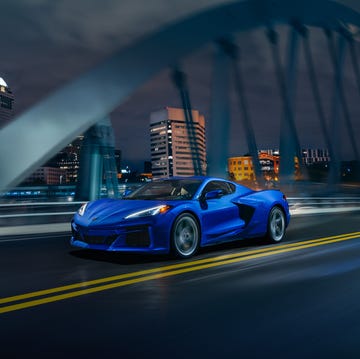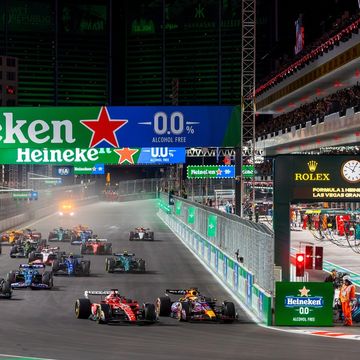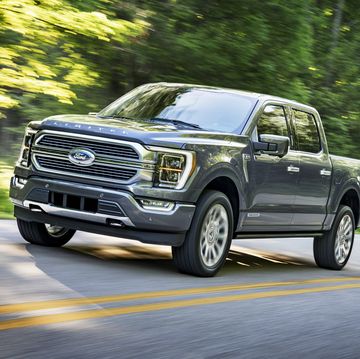Esquire's 2015 Car Awards
Cars have never been better, as our four finalists and Car of the Year demonstrate.

Published in the November 2015 issue
Plus: More of the best cars of the years here.
We realize what we are about to tell you is not going to stir the loins, but here's the thing: We are living in a golden age of sedans. (There is no other way to say it.) Each of the four Esquire Car of the Year finalists is demonstrably as good as any sedan has ever been. It's the only category of car that doesn't require a compromise: not on speed, quickness, handling, space, styling... not on cupholders. Thing is, not enough people are buying them. To us, this makes no sense. No trucks this time and only one SUV. It's time to celebrate cars again. Because cars—actual cars—have never been better.
The 2016 Cadillac CTS-V Should Be Esquire's Car of the Year

The 2016 Cadillac CTS-V should be Esquire's Car of the Year because it is the most inspiring story in cars right now. In the depths of the recession, when the entire American auto industry was on the edge, Cadillac decided to start over—first with the ATS line and then, more spectacularly, with the CTS line, which starts at $46,555—and succeeded in engineering a vehicle that argues convincingly that it is the premier performance sedan in the world, a car capable of outrunning any sedan from Mercedes or BMW or Audi. Did I mention it's from Detroit?
The Cadillac CTS-V should be Esquire's Car of the Year because the first time we drove the current-model CTS, it provided the most thrilling drive of a day that included more than forty cars, the redesigned Corvette Stingray among them. It was winter in Michigan and it had snowed, so we were locked out of GM's Proving Ground. We made do by taking to the ten miles of two-lane that circumnavigate the perimeter. Clockwise around the back, there's a long, gentle downhill, with a mild right-hand turn that slingshots you into something like an actual racetrack-type straightaway. I hit that stretch at speed and got that holy-shit rush of being entirely in control while hurtling forward at a rate at which control should be tenuous. And then I did it over and over again, and each time the rush took my breath away.
The CTS-V should be the Car of the Year because the car I drove in Michigan eighteen months ago was not even the V, with 640 horsepower. It was the CTS V-Sport, the $60,950 six-cylinder version (which still manages to pump out 420 hp).
The CTS-V should be the Car of the Year because it's new right now (which is what qualifies it for this competition) and because when I took it to the lonely stretch of wooded road on which I do my completely unscientific 0-to-60 testing and tromped on the accelerator, I wondered for just a second if the world was ending, what with the noise and the sudden, intense pull of gravity and the slight smell of something like melting rubber.
The CTS-V should be the Car of the Year because it ought to be the halo product that forces the world to reevaluate Cadillac. The cars that tend to inspire me share two traits: They are understated and they are overpowered. There is no car that is more understated than the Cadillac CTS-V. Although this is a potential blessing for consumers of great cars, it's a problem for Cadillac given that the number of people who buy the CTS-V is less than is warranted by its sophistication, performance, and raw power. The blessing is that you (or I) can, for a while at least, be one of the lucky ones who drive it.
This, friends, has to be the Car of the Year.
—David Granger
The 2016 Dodge Charger SRT Hellcat Should Be Esquire's Car of the Year

Consider the 2016 Hellcat. Specifically the Dodge Charger Hellcat, because there are two. The Dodge Challenger Hellcat is a coupe, lean and cramped inside. The Charger Hellcat is the four-door, built on the bones of Dodge's rear-drive rental-car Charger. The drivetrain is a 6.2-liter supercharged Hemi V-8 that produces 707 hp—this is not a typo.
That engine. Oh my gentle, tire-roastin' Jesus. Mind-altering thrust. It prompts questions: What do you do with 707 hp? (Answer: What don't you?) Why does the world's most powerful mass-produced automobile look like an undercover cop car? (Why not?) Do you really need to roll around in a mantle of tire smoke and vaporized dinosaur? (These days, that pastime has a clock. Live it up.) You can luxuriate in traffic or inhale countries in comfort, four adults and luggage, because it's a Dodge. Try either with your Lamborghini. You can spend $25,000 more on a Porsche 911 and be 357 horses short. The Hellcat is an atomic sofa, softly sprung and powered by the kind of stars-and-stripes fury usually reserved for battleship cannons.
But this is not the emotion of the thing. The Hellcat lives or dies on the loss of your mind. And everyone who drives it loses their mind—at 5 mph, 40, 100. I cackled. I left every stoplight half-sideways, because the engine is always more than you need or could possibly imagine wanting. And because the car's government-mandated stability-control system lets you do silly things while it's on, like ferocious pavement abuse. Naturally, I turned it off and did a rolling burnout in second gear. Then third. Then, astonishingly, fourth.
No one saw this coming. Not even Dodge, which can't build the things fast enough. There's a waiting list; dealers are tagging on crazy markups, and people are happily paying. You drive down any main street in America, pedestrians jump off the sidewalk to yell at you. "You got the Hellcat!" one guy in Detroit joyously said. "That's a car!" I didn't argue. Hellcats don't have a visible name badge—Detroit's idea of restraint—but he knew anyway. Throughout history, the world has reacted like this to a handful of American cars: the first Mustang, the first Corvette, the first Viper. And you know what happened to them.
Maybe the success of this thing says we are a flawed people, a nation indulgent and loud. Maybe I can live with that. Maybe I can live with an annual tire budget greater than the cost of the fuel I burn. Seven hundred ponies and a hundred-thousand-mile powertrain warranty? This is a machine of an exact moment in time, possible only through the intersection of the supercomputerized automobile and the waning, irresponsible days of the gasoline engine. It is obviously not for everyone. But if you've paid the money and are waking the neighbors with exhaust snort on your way to work, I highly doubt you give a shit. You are part of a beautiful moment. If that isn't the Esquire Car of the Year, I don't know what is.
—Sam Smith
The 2016 Mercedes-AMG C63 Should Be Esquire's Car of the Year

Would you rather have your V-8 twin-turbo hand-built by one conscientious man with the balls to put his signature on top of the engine block or slapped together by an endless line of robots? Would you rather be serviced by a company that practically invented the automobile engine or be lumped in with every other dickhead on the road to fix a recalled part? These were the questions world-class racing driver, coach, and instructor René Villeneuve asked me when I told him about the final four in Esquire's Car of the Year backstage at Jones Beach Theater. (I mean, c'mon, isn't that where you're supposed to hang with race-car drivers?) He went on. Let's put it this way: The 2016 Mercedes-AMG C63 is not particularly good at one thing... it happens to be great at everything. Given its balance and speed, it's the car that instructors love to use for teaching. Maybe René's opinion is a little biased. He's an instructor not only at the Skip Barber Racing School but also at the AMG Driving Academy. Regardless, the man lives for fast cars, and I must humbly admit as a lowly motorist that the C63 is amazingly fast. Sure, there are faster cars out there, but who can actually tell the difference between 500 and 700 hp? Me? No chance. Are there cars that might be quicker right off the line? Sure. But who wants to worry about how many miles you have left before you need to park and recharge for hours? As far as groundbreaking electronics and beautiful interiors are concerned, what other manufacturer has beaten Mercedes to the punch... ever? The AMG C63 is a muscle car disguised as a sedan, with the perfect blend of elegance and brutal power.
What's most impressive is the distinctiveness of each of its driving modes. Comfort is incredibly smooth and quiet, and the engine responds quickly as you merge onto the highway. Sport mode is still quiet, but the steering, suspension, and rpm's are on high alert. Then there's Sport +, as if Sport weren't good enough for this engine. Sport + completely unleashes the monster underneath your ass as the V-8 revs high and the exhaust noise spits, sputters, and screams. When you hit 4000 rpm, you're thrown back in your seat. The steering and suspension are locked into your nervous system, and you can't believe you just cornered at that speed on this particular stretch of country road. The price range starts at about $64,000 for a 451-hp, 6.3-liter V-8 coupe, and then increases to $74,175 for the 503-hp AMG C63 S. With all the autonomous-driving add-ons, including the most beautiful heads-up display you've ever seen, you can take this baby up to around 100K, but that isn't even necessary. At its most basic, this car will let people know you're a man with good taste, you're serious about driving, and you're not willing to be categorized with all the other drivers—even drivers of fast cars. You don't even need to be a race-car driver to figure that out.
—David Curcurito
The 2016 Tesla Model S P90D Should Be Esquire's Car of the Year

I ask respectfully: What more do you need?
Is it range you want? Install a charge in the wall of your garage. This is a commuter car. This is a car for people who drive the same distance every day. Depending on the model, you'll have almost 270 miles of range ready to roll. What's your commute? Sixty miles a day? You'll be fine. The fact is you can't depend on supercharging stations yet; there are a little more than five hundred in the United States. There are way more than a hundred thousand gas stations. I get it. The home charger is the way. Is it price you want? Fine. The 2016 P90D is expensive; it can top out at over $130,000. Get the Model S 70. It starts at $76,200.
Is it space you want? You can wait for the Model X SUV, which just came out. Or you could have Tesla install a couple rear-facing child jump seats in the back of your Model S for $3,000. You open the giant hatch and your kids spill out. You now effectively own a minivan without becoming a driver of a minivan, which is perhaps Elon Musk's single greatest achievement.
Is it speed you want? Fine. The Tesla Model S can't compete with the C63 or the CTS-V or the Charger at speed, at least not speed past, say, 80 miles per hour. But is speed really the thing?
Fast is overrated. It's quick you want. Low-end torque is what flattens your lungs. Low-end torque is what thrills your passenger. Low-end torque is what allows you to use a forty-foot on-ramp to immediately match speeding traffic.
The torque is the thrill—a useful thrill.
Is Tesla the quickest-accelerating car? No. But it is the quickest-accelerating electric car, and it beats all but a few gas-powered production vehicles. And accelerating in an electric car is not like accelerating in a gas-powered car. There's always a lag with a regular car. A crescendo. The quickness of a Tesla is the quickness of an electric roller coaster. You don't accelerate. You launch—in total silence. In a gas-powered car, you're rattled by vibration, you hear thunder, you might smell something burning. Which is pure America, I get it. In the Tesla, the only sensation is gravity. It is exhilarating. It is alarming. It is freaky. It is wonderful.
Is it attitude you want? Tesla flaunts that quickness by calling its ultraquick acceleration mode Ludicrous (which is just a few tenths of a second faster than its Insane mode). It's pure marketing, but it's also funny. How many cars are funny? Cars should be funny.
Obviously, the Tesla Model S P90D should be the Car of the Year. And until another high-performance electric vehicle comes along to best it (virtually every German automaker has one in the works; AudiV 's electric SUV should be here in a few years), it should be for years to come.
—Ross McCammon
The 2016 Mercedes-AMG C63 Is the Car of the Year

This whole process is never easy. Yes, we drive every new car on the market. No hardship, and just as much fun as you'd think. It's the winnowing that's hard. In the beginning, there are two groups: Clunkers and Good Ones. You throw out the former, leave the latter. Then you divide again, into Good and Better. Then again, into Great and Amazing
And then it gets itchy.
If a car has made it into these pages, we think it's pretty fantastic. Beyond that, the big lesson—the takeaway you get from driving the best cars in the world—is that taste is everything. Good machinery is like good food: Just because something's spectacularly crafted doesn't mean you will like it. And vice versa.
After hours of discussion, arguments, and banter, the vote was unanimous: The 2016 Mercedes-AMG C63 is what we want in a car, but also what we think most of you want. Understated, yet with a healthy dose of style. Gobs of power, more than you need, but not to the point of being irresponsible. Costly but not unreachable; versatile but focused. The 4.0-liter twin-turbo V-8 is efficient and seamlessly powerful, brutal yet docile in traffic. It whomps and crackles, the noise alone threatening to peel your hair off your scalp. The interior is beautifully crafted, full of wonderfully satisfying touches—the clicking of the crosshair dash vents! the substantial thunk of the door handles!—but not ostentatious. You can do the silly, terrible things you can do in a Hellcat, but you won't burn fuel like a 747. You can travel long distances with ease—no waiting for a battery charge every few hours—which you can't do in a Tesla. You don't have to explain away subpar details, as you do with the Cadillac.
These are all fine machines, but the Mercedes requires no caveat. Like all balanced fast cars, it's simultaneously calming and thrilling. The people who built it seem to understand the importance of focus, restraint, and joy. It's a thing for you, for us, for the closet wild man and the calm adult and just about everyone in between. It's a toe-curling, balls-out riot, fast as hell and properly balanced. It's the Esquire Car of the Year.
—The Edtiors
Watch Next


The 12 Best Checked Luggage Pieces for Traveling

The 2024 Lexus GX Is in a Class of Its Own

The 12 Best Garment Bags for Easy Travel

The 2024 Nissan Rogue Is Making Its Great Escape







